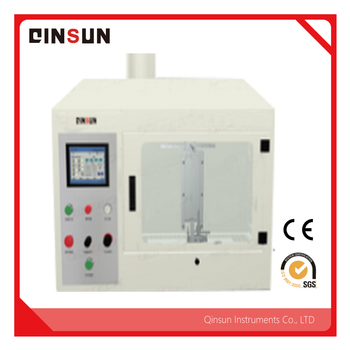
NewsInformation Center
EN ISO 11925 Building Materials Combustibility Test Chamber
2023/09/04
EN ISO 11925 is a specific standard that outlines the test method for assessing the reaction to fire behavior of building materials subjected to direct impingement of flame. In this context, a Building Materials Combustibility Test Chamber refers to the equipment and methodology used to conduct tests according to this standard.
The test chamber, in compliance with EN ISO 11925, creates controlled conditions to evaluate the combustibility of building materials. It involves exposing the specimen to a direct flame for a specified duration while monitoring parameters such as flame spread, burning behavior, heat release, and smoke production.
By following the guidelines provided in EN ISO 11925, manufacturers, researchers, and regulators can assess the fire performance and safety characteristics of different materials used in construction. These tests help determine if a material meets the specified requirements for fire resistance and contribute to the development of fire-safe building practices.
EN ISO 11925 Building Materials Combustibility Test Chamber Operating Procedures:
Here is a general outline of the operating procedures:
1. Preparing the specimen: Ensure that the building material specimens are properly prepared according to the required dimensions and conditioning procedures specified in EN ISO 11925.

2. Setting up the test chamber: Set up the test chamber in accordance with the manufacturer's instructions. This typically involves connecting any necessary gas or electrical supply lines and ensuring that the chamber is clean and free from any residual materials.
3. Calibrating instrumentation: Ensure that all instruments and sensors within the chamber are properly calibrated and functioning correctly. Calibrations may include temperature sensors, gas flow meters, and heat flux meters.
4. Specimen installation: Place the prepared specimen in the designated location within the test chamber, ensuring appropriate positioning and alignment.
5. Test conditions and parameters: Set the test conditions according to EN ISO 11925, including the specific heat flux, duration of exposure, and any additional requirements mentioned in the standard.
6. Ignition source application: Apply the ignition source to the specimen as required by the standard. This may involve using a gas burner or other suitable means of direct flame impingement.
7. Data acquisition: Continuously record and monitor various parameters during the test, such as temperature, flame spread, smoke production, and heat release. This data is crucial for analyzing the material's reaction to fire.
8. Test completion: Once the specified test duration is complete, carefully remove the specimen from the chamber, taking the necessary precautions to avoid any potential hazards.
9. Data analysis and reporting: Analyze the test results according to the requirements of EN ISO 11925. Evaluate the material's reaction to fire characteristics, including flame spread, burning behavior, heat release, and smoke production. Generate a comprehensive test report summarizing the findings.
Remember, it is vitally important to consult the specific instructions provided by the chamber manufacturer as well as the requirements of EN ISO 11925 to ensure accurate and safe operation of the Building Materials Combustibility Test Chamber.
Any interested customers, please leave a message online, we will provide a quotation within 24 hours, welcome to inquire!
Any interested customers, please leave a message online, we will provide a quotation within 24 hours, welcome to inquire!
Previous: How do you test the combustibility of automotive interior material?
N e x t : What is the elevated temperature oxygen index?



